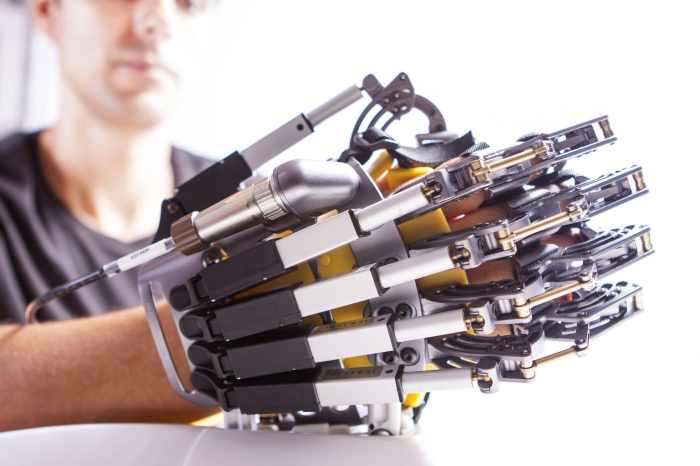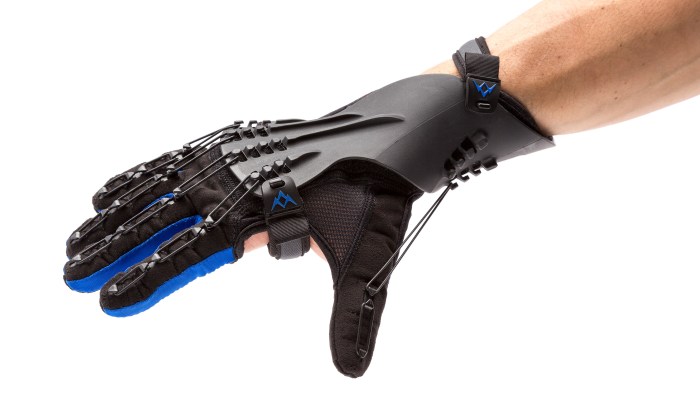Introduction to Robotic Hand Rehabilitation
Stroke, a debilitating condition affecting the brain, often leaves individuals with impaired hand function. The impact on daily life can be significant, making simple tasks like dressing, eating, and writing extremely challenging. While traditional rehabilitation methods have proven beneficial, the recovery process can be lengthy and arduous. This is where robotic hand rehabilitation emerges as a promising solution.
Challenges Faced by Stroke Patients During Rehabilitation
Recovering hand function after a stroke can be a daunting task. Stroke patients often face various challenges, including:
- Weakness and Spasticity: The affected hand may experience weakness and spasticity, making it difficult to control movements.
- Loss of Dexterity and Coordination: Stroke can disrupt the brain’s signals responsible for fine motor control, leading to a loss of dexterity and coordination.
- Pain and Fatigue: Rehabilitation exercises can be physically demanding, causing pain and fatigue, which can hinder progress.
- Motivation and Adherence: The long and repetitive nature of traditional rehabilitation can lead to decreased motivation and adherence to therapy.
Robotic Hand Rehabilitation: A Promising Solution
Robotic hand rehabilitation offers a structured and engaging approach to address these challenges. It involves using specialized robotic devices that provide:
- Assisted and Resistive Movements: Robots can assist patients with movements, providing support and guidance while simultaneously encouraging active participation.
- Repetitive and Intensive Training: Robots allow for repetitive exercises, enabling patients to engage in intensive training that promotes neural plasticity and functional recovery.
- Personalized Therapy: Robotic systems can be customized to individual needs and goals, ensuring a tailored rehabilitation experience.
- Objective Feedback and Progress Monitoring: Robots provide real-time feedback on performance, allowing therapists to monitor progress and adjust treatment plans accordingly.
How Robotic Hands Work
Robotic hands used in rehabilitation are designed to mimic the functionality of a human hand, providing patients with a means to regain lost dexterity and motor skills. These devices are intricate systems that combine mechanical engineering, sensors, and control algorithms to achieve their remarkable capabilities.
Types of Robotic Hands
The different types of robotic hands used in rehabilitation are categorized based on their design, functionality, and intended use.
- Exoskeletons: These devices are worn over the patient’s hand and provide support and assistance to their movements. They are often used for patients with weakness or limited range of motion in their hand and fingers.
- End-effectors: These are robotic devices that replace the patient’s hand entirely. They are often used for patients who have lost their hand or have a severe impairment.
- Hybrid Systems: These systems combine aspects of both exoskeletons and end-effectors. They offer a more comprehensive approach to rehabilitation, providing both support and replacement functionality.
Principles of Robotic Hand Movement and Control
Robotic hand movement is controlled by a combination of mechanical actuators, sensors, and control algorithms.
- Actuators: These are the motors that drive the movement of the robotic hand. They can be powered by electricity, pneumatics, or hydraulics.
- Sensors: Sensors are used to provide feedback about the position, velocity, and force of the robotic hand. This information is used by the control algorithms to adjust the movement of the hand in real-time.
- Control Algorithms: Control algorithms are software programs that determine how the robotic hand moves and interacts with its environment. They are designed to mimic the natural control of the human hand.
Role of Sensors and Feedback Mechanisms, Robotic hand could help with stroke patient rehabilitation
Sensors play a crucial role in robotic hand rehabilitation by providing real-time information about the hand’s movement and interaction with its environment. This feedback is essential for the control algorithms to make adjustments and ensure smooth, safe, and effective movements.
- Position Sensors: These sensors track the position of the robotic hand’s joints and fingers. They are crucial for maintaining accuracy and control during movement.
- Force Sensors: Force sensors measure the forces exerted by the robotic hand on objects. This information is used to ensure safe and controlled grasping and manipulation of objects.
- Skin Sensors: Some robotic hands are equipped with skin sensors that detect touch and pressure. This information is used to improve the hand’s ability to grasp objects with different textures and shapes.
Benefits of Robotic Hand Rehabilitation
Robotic hand rehabilitation offers a promising avenue for stroke patients to regain hand function and improve their quality of life. These devices provide structured and repetitive exercises, helping patients overcome the challenges of regaining hand movement and dexterity after a stroke.
Improved Hand Function, Strength, and Dexterity
Robotic hand rehabilitation devices are designed to mimic the natural movements of the hand, providing targeted exercises that promote muscle strengthening and coordination. The repetitive nature of these exercises helps retrain the brain to control hand movements, leading to improved dexterity and fine motor skills.
The use of robotic devices can enhance hand function, strength, and dexterity in stroke patients by providing targeted and repetitive exercises.
Comparison with Traditional Therapy Methods
While traditional therapy methods are valuable, robotic hand rehabilitation offers several advantages. Robotic devices can provide:
- Increased Intensity and Duration of Therapy: Robotic devices can provide longer and more intense therapy sessions, leading to faster improvements in hand function.
- Personalized Therapy: Robotic devices can be programmed to tailor exercises to the specific needs and abilities of each patient.
- Objective Feedback: Robotic devices provide objective data on the patient’s progress, allowing therapists to monitor their recovery and adjust treatment plans accordingly.
Examples of Successful Cases
Numerous studies have documented the effectiveness of robotic hand rehabilitation in stroke patients. For instance, a study published in the journal “Stroke” found that robotic therapy led to significant improvements in hand function and dexterity in stroke patients compared to traditional therapy alone.
Robotic hand rehabilitation has been shown to be effective in improving hand function and dexterity in stroke patients, with studies demonstrating its effectiveness compared to traditional therapy.
Types of Robotic Hand Therapies: Robotic Hand Could Help With Stroke Patient Rehabilitation
Robotic hand therapy systems are designed to aid stroke patients in regaining hand function by providing structured exercises and feedback. These systems offer a personalized approach to rehabilitation, allowing patients to practice specific movements and improve their motor skills.
Robotic Hand Therapy Systems
Different robotic hand therapy systems are available, each with unique features and target patient groups. Here’s a table outlining some popular systems:
| System | Features | Target Patient Group | Limitations |
|---|---|---|---|
| InMotion ARM | Provides passive and active exercises for the shoulder, elbow, and wrist. Offers real-time feedback and customizable training programs. | Patients with stroke, traumatic brain injury, and other neurological conditions affecting upper limb function. | Can be expensive and may require specialized training for therapists. |
| SaeboGlove | Provides assistance with finger extension and grasp. Offers adjustable levels of support and feedback. | Patients with stroke, cerebral palsy, and other conditions causing hand weakness. | Limited range of motion compared to other systems. |
| NeReHa | Offers a combination of passive and active exercises for the hand and wrist. Provides visual feedback and customizable training programs. | Patients with stroke, spinal cord injury, and other conditions affecting hand function. | Can be bulky and require a dedicated workspace. |
Specific Robotic Hand Therapies
Robotic hand therapy systems facilitate various exercises and training programs tailored to address specific hand impairments.
Finger Extension Exercises
These exercises aim to improve finger extension, a crucial movement for grasping and releasing objects. Robotic systems provide assistance and resistance to help patients regain control over their finger extensors.
Grasping Tasks
Robotic systems can simulate grasping tasks, allowing patients to practice picking up and holding objects of different sizes and shapes. This training enhances hand coordination and dexterity.
Object Manipulation Training
Patients can practice manipulating objects using robotic systems. These exercises involve activities like turning a knob, opening a bottle, or using a keyboard, promoting functional skills for daily activities.
Virtual Reality and Gaming Elements
Integrating virtual reality (VR) and gaming elements into robotic hand rehabilitation can enhance patient engagement and motivation. VR environments provide immersive and interactive experiences, allowing patients to perform exercises in a more stimulating and enjoyable setting.
Games designed for rehabilitation can challenge patients to complete tasks using their affected hand, fostering motor skill development and promoting cognitive function. For example, patients might play a virtual game requiring them to pick up and move objects, or they might control a virtual avatar using their hand movements.
Considerations for Robotic Hand Rehabilitation
Choosing the right robotic hand rehabilitation program is crucial for maximizing the benefits and achieving the desired outcomes. Several factors need careful consideration to ensure a successful and effective rehabilitation journey.
Patient’s Condition and Goals
The patient’s individual condition, including the severity of the stroke, the affected hand’s functionality, and any pre-existing conditions, plays a significant role in determining the suitability of robotic hand rehabilitation. The patient’s goals, whether it’s regaining functional independence, improving hand dexterity, or reducing pain, should be clearly defined to tailor the rehabilitation program accordingly.
Access to Resources
The availability of resources, including qualified therapists, appropriate robotic equipment, and financial support, is essential for successful robotic hand rehabilitation. The program should be accessible and affordable, ensuring that the patient can participate without significant financial burden.
Potential Risks and Limitations
While robotic hand rehabilitation offers significant benefits, it’s essential to acknowledge potential risks and limitations. These include the possibility of discomfort or pain during therapy, the risk of overuse injuries, and the potential for equipment malfunction. It’s crucial to choose a program with experienced therapists who can monitor the patient’s progress and adjust the therapy as needed.
Future Advancements in Robotic Hand Rehabilitation
The field of robotic hand rehabilitation is constantly evolving, with ongoing research and development leading to new advancements. Future innovations may include:
- More personalized and adaptive robotic devices that can adjust to individual patient needs and progress.
- Virtual reality (VR) and augmented reality (AR) technologies integrated into rehabilitation programs to enhance engagement and provide immersive experiences.
- Artificial intelligence (AI) algorithms that can analyze patient data and provide real-time feedback and guidance.
Robotic hand could help with stroke patient rehabilitation – The rise of robotic hand rehabilitation marks a significant advancement in stroke recovery, offering a more targeted and effective approach to regaining hand function. As technology continues to evolve, we can expect even more sophisticated robotic systems to emerge, further empowering stroke survivors to reclaim their independence and quality of life. This is not just about restoring physical abilities; it’s about restoring hope and empowering individuals to live fulfilling lives after a stroke.
Imagine a future where stroke patients regain their dexterity with the help of robotic hands, all while streaming their favorite shows on a Google Home Chromecast Ultra, rumored to be available at a price point that won’t break the bank. google home chromecast ultra rumored prices could make this future more accessible, allowing stroke patients to focus on their rehabilitation while enjoying entertainment at a reasonable cost.
This combination of innovative technology and affordability could truly revolutionize stroke recovery.
 Standi Techno News
Standi Techno News

